Future Bleak for Australia’s Aluminium Smelter Sector
Although forecasts say global aluminium prices may go up for the first quarter of 2012, prospects are bleak for the aluminium sector in Australia.
The Norsk Hydro aluminium smelter plant at Kurri Kurri closed on of its three potlines which would result in the lay off of 150 workers. The Tomago Aluminium also underwent a major restructuring which would lead to the loss of another 100 jobs.
The two developments have not surprised the New South Wale Hunter Valley aluminium industry since both firms have been suffering financial the past few months and workers were aware of the situation.
Norsk's Kumi smelter has 500 employees. The firm will declare the 150 redundant over a period of time cutting across all departments.
Tomago Aluminium, which has 1,200 employees, will also implement several cost-cutting measures aside from reducing its manpower by 100 workers.
The two firms blame the strong Australian dollar and low metal prices for the job cuts and weak performance.
Olaf Wigstol, senior vice president of Norsk, said the lay offs were in response to the weak macroeconomic environment and uncertain market outlook. Part of the restructuring in Norsk is the appointment of Egil Fredriksen as new chief executive to replace Alberto Fabrini who was given a new assignment.
Norsk's Kurri Kurri smelter was the first aluminium smelter to open in NSW in June 1969. The firm built over the years three potlines with different technologies. Mr Wigstol said the closure of that smelter would definitely impact the plant financially although the firm expects operations to remain unprofitable despite the job cuts.
The 150 job cuts are in addition to the 45 cuts that Norski made in late 2011. With the closure, the company's yearly production would go down by 80,000 tonnes to 120,000 tonnes a year.
The Tomago smelter is expected to operate at full capacity and retain current annual production of 530,000 tonnes of aluminium despite the lay off of 100 workers.
Light Metal Age, the publication of the light metal industry, lists six aluminium manufacturers in Australia with a total capacity of 2,060,000 tonnes per year. Tomago accounts for 26 per cent of the total capacity while Norsk accounts for only 9 per cent.
From a high of $2,800 per tonne in May 2011, global prices for aluminium declined to less than $1,900 in January 2012.
Mukesh Kumar, chief operating officer of Vedanta Resources, India's largest producer of aluminium smelter, forecast that prices could go up to $2,300 per metric tonne at the London Metal Exchange by end of March. The price of aluminium, used for the manufacture of cars and airplanes, was at $2,164 on Wednesday and last closed above $2,300 on Sept 21.
Mr Kumar told Bloomberg the expected increase in aluminium smelter prices is because of more manufacturing activities in China and India which would lead to more sales of vehicles and consumer appliances which also use the resource.
There would also be a supply shortage of aluminium in the global market for the first half of 2012 because of 15 per cent idle capacity of smelters as a result of the debt contagion in Europe and initiatives by China to curb inflation.
The Indian government also plans to boost its spending on public works and utility projects to $1 trillion for the next five years as the south Asian nation targets to reach a 9 per cent economic expansion.
Indian Prime Minister Manmohan Singh said last week that the country's gross domestic product growth rate would likely reach 7 per cent for the year ending March 31, which is lower than the 7.5 per cent growth rate projected in December.
Another analyst from Davenport said aluminium prices will continue to go up through 2013 since more than 40 per cent of global capacity run at a loss and these firms would likely cut output, which would boost prices.






